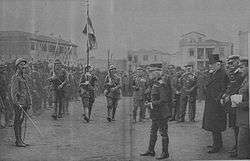Greece during World War I
At the outbreak of World War I in August 1914, the Kingdom of Greece remained a neutral nation. Nonetheless, Greek forces in October 1914 occupied Northern Epirus, a territory of southern Albania that it claimed for its own, at a time when the new Principality of Albania was in turmoil. At the same time, the Kingdom of Italy occupied Sazan Island, another Albanian possession, and later that December the Albanian port of Vlorë.
Road to War
Greece had signed a defense treaty with the Kingdom of Serbia in 1913 that obliged Greece to come to Serbia's aid if it were attacked from the Kingdom of Bulgaria. When Bulgaria began mobilization against Serbia in 1914, the Greek Prime Minister Eleftherios Venizelos believed that he could get Greece to join the war on the side of the Allies if they landed 150,000 troops in Salonika. Venizelos failed to bring Greece into the war on the Allied side. His explanation that this was because King Constantine I was a "German sympathiser". The king and the anti-Venizelists (opponents of the prime minister) were opposed to joining the war and argued that the Serbo-Greek Treaty was void if one of the great powers fought alongside Bulgaria. However, British, Australian and New Zealand ships and troops were allowed to use the island of Lemnos as a base from which their attack on Gallipoli was mounted in 1915 {see Gallipoli Campaign). Venizelos was unconstitutionally removed from office by the king on 5 October 1915, only to return to the political scene in October 1916.
Venizelos invited a joint Franco-British (and later also Russian) expeditionary force, formed in part by withdrawals from Gallipoli, transforming Salonika into an Allied military base. (Keegan 253) Forces began to arrive on 3 October 1915. In the early summer of 1916, the Athens government under King Constantine handed over Fort Rupel to the Germans, believing it a neutral act, though claimed as a betrayal by the Venizelists. Nonetheless, the Allies still tried to swing the official Athens government to their side. From their positions in Greece, Allied forces (British, French, and Russian, Italian, and Serb troops) fought the war from Greek territory, engaging Bulgarian forces when they invaded Greece in August 1916 in the Battle of Struma.
Greece joins the war

In August 1916, Venizelist officials staged a coup d'état that prompted Venizelos to leave Athens. He returned in October 1916 and set up a rival government in Salonika. Allied efforts to persuade the royal government in Athens to abandon its neutrality and join them failed, and relations irreparably broke down during the Noemvriana, when French and Greek troops clashed in the streets of the Greek capital. The Greek Army, mostly loyal to the royal government, was largely disarmed and obliged to retreat to the Peloponnese, while the warships of the Greek navy were impounded and manned by French crews. Still, King Constantine, who enjoyed the protection of the Russian Tsar as a relative and fellow monarch, could not be removed until after the February Revolution in Russia removed the Russian monarchy from the picture. In June 1917, King Constantine abdicated from the throne, and his second son, Alexander, assumed the throne as king. Venizelos assumed control of the entire country, while royalists and other political opponents of Venizelos were exiled to France and Italy. Greece officially declared war against the Central Powers on 30 June 1917 and would eventually raise ten divisions for the allied effort, alongside the Royal Hellenic Navy.
Participation in the war

The Macedonian front stayed mostly stable throughout the war.. In May 1918, Greek forces attacked the Bulgarian forces and defeated them at the Battle of Skra-di-Legen on 30 May 1918. Later in 1918, the Allied forces upped up their offensive from Greece into occupied Serbia. In September of that year, Allied forces (French, Greek, Serb, Italian, and British troops), under the command of French General Franchet d'Esperey, broke through German, Austro-Hungarian, and Bulgarian forces along the Macedonian front. Bulgaria later signed the Armistice of Thessalonica with the Allies in Thessaloniki on 29 September 1918. By October, the Allies including the Greeks under French General Louis Franchet d'Espérey had taken back all of Serbia and were ready to invade Hungary until the Hungarian authorities offered surrender.
After the war
Since Greece found itself on the winning side of World War I at its conclusion, it was rewarded with territorial acquisitions, specifically Bulgarian territory on the Aegean Sea in the Treaty of Neuilly-sur-Seine and Eastern Thrace and the Smyrna area in the Treaty of Sèvres. The Greek military suffered an estimated 5,000 dead (Gilbert, 1994: 541) from their nine divisions that participated in the war.
References
- Gilbert, Martin (1994). The First World War.
- Keegan, John (1998). The First World War.
- Strachan, Hew (1998). World War I: A History.